
(The Royal Sweden Caviar's, a Treasure from the Arctic Sea!)
THE FISH EGG's! Possible one of the future superfoods!
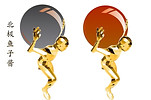


Fisheggs and Nutrition! The Caviar's.
Caviar is the word of preserved Fish Eggs, (Roe) and can come from all different kinds of fish, including the beluga sturgeon (the true caviar), , Lumpfish, Capelin, Salmon and Trout (the eggs in sushi),
All the different kinds of roe are very nutritious, but Lumpfsih, Capelin, Salmon and Trout roe are much more affordable for most people compared to he more fancy caviars. They’re also more environmentally friendly – overfishing has depleted the natural populations of beluga sturgeon so much of the fish eggs in the market is farmed .
Nutritionally, cold water fish eggs share one important benefit with fish oil supplements: they’re very high in anti-inflammatory Omega-3 fats. Since roe is a natural source of these fats, it even beats out a supplement for nutritional quality, since there’s much less risk of the fats oxidizing during processing.
Like most real foods, fish eggs also have more than one nutritional benefit. As one of the few food sources of Vitamin D (others include chicken eggs and fatty cold-water fish), roe is a great supplemental food, especially during the winter. Like Omega-3, Vitamin D is even better from a whole food than from a supplement, since the whole food version contains other vitamins and minerals in an unprocessed form, without any fillers or additives. In fact, the Omega-3 fats and the Vitamin D in roe even work together, because Vitamin D is fat-soluble, so the healthy fats help your body absorb and use it.
According to an analysis carried out by the Weston A. Price Foundation, a single tablespoon of fish roe contains approximately 17,000 international units of vitamin D! In addition, fish roe contains vitamins A, K2, zinc, iodine, and the brain supporting omega 3 fatty acid DHA in ample amounts.
Roe is also rich in Vitamin B12, one of the most important micronutrients for mental health and brain development. Like other seafood, it contains a substantial amount of selenium, a micronutrient otherwise hard to get, except from Brazil nuts. Magnesium, iron, and even a little bit of calcium round out an already impressive set of nutrition facts.
Before humans even had names for these vitamins, people in traditional cultures already knew how powerful roe was. Fish eggs are one of the most potent traditional “superfoods” for fertility, and Weston A. Price observed many cultures going to extreme lengths to feed roe to their pregnant women. Now, even the USDA is recommending that parents include it in their babies’ diets, although they would probably do better to recommend it for everyone. http://www.thehealthyhomeeconomist.com/fish-eggs-a-superior-vitamin-d-boost/
The Lumpfish Caviar's!
LUMPFISH (Cyclopterus lumpus).
The Lumpfish is a thick and somewhat ball-shaped fish, mostly used because of the Roe’. The females can be more then 50 cm long, while the males usually are a bit smaller. Our Lumpfish is fished in Arctic water near Norway, Iceland and Greenland. The Lumpfish spend most of their time in the open ocean, however, and usually only come to shallower waters to spawn. Their spawning behavior is quite distinct – males arrive at breeding grounds early to make a nest in kelp beds and wait for a female. Spawning takes place and the big females can carry from 350 000 to 400 000 eggs., the females leave and the males will attend to and aggressively defend the eggs until they hatch.
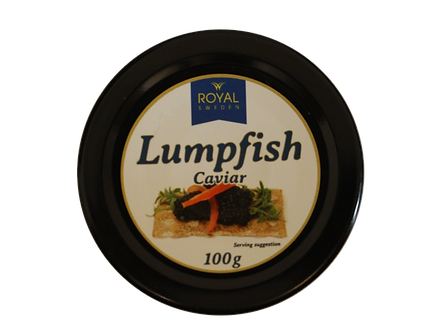


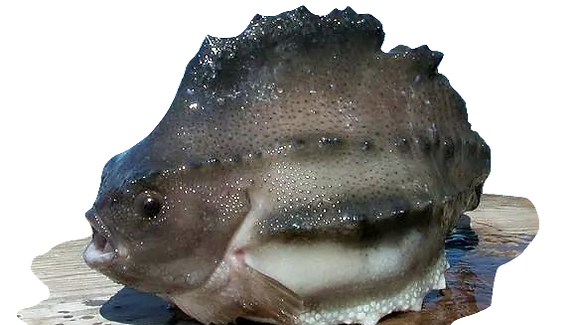
Lumpfish Black 100g
Lumpfish Red 100g
The Capelin Caviar's!
The Capelin, (Mallotus villosus),
The Capelin is a small boreoarctic pelagic schooling fish of the smelt family found in the northern Atlantic and Arctic oceans. In summer, it grazes on dense swarms of plankton at the edge of the ice shelf. Capelin spawn on sandy beaches and sandy bottom at the age of 2–6 years. Males reach 20 cm in length, while females are up to 25 cm long.
Barents Sea capelin migrate during winter and early spring to the coast of northern Norway (Finnmark) and the Kola Peninsula (Russia) for spawning. During summer and autumn capelin migrate north- and north-eastward for feeding.
The world’s largest known capelin population has historically dwelt in the Barents Sea, off of the northern coast of mainland Norway (Hjermann et al. 2004).
Commercially, capelin is used for fish meal and oil industry products, but is also appreciated as food. Capelin roe (“Masago”) is considered a high-value product. It is also sometimes mixed with wasabi or green food coloring and wasabi flavor and sold as “wasabi caviar”. Often, Masago is used as a substitute for Tobiko, flying fish roe, due to its similarity and taste although the mouthfeel is different due to the individual eggs being smaller and it is less crunchy than Tobiko.


Capelin Black
100g
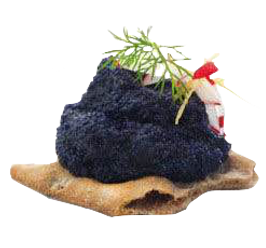

Capelin Red
100g
The Trout Caviar!
The Trout, (Oncorhynchus mykiss),
Trout is the common name for a number of species of freshwater fish belonging to the genera Oncorhynchus, Salmo and Salvelinus, all of the subfamily Salmoninae of the family Salmonidae. The word trout is also used as part of the name of some non-salmonid fish such as Cynoscion nebulosus, the spotted seatrout or speckled trout.
Trout are closely related to salmon and char (or charr): species termed salmon and char occur in the same genera as do trout (Oncorhynchus - Pacific salmon and trout, Salmo - Atlantic salmon and various trout, Salvelinus - char and trout).
Most trout such as lake trout live in freshwater lakes and/or rivers exclusively, while there are others such as the rainbow troutwhich may either live out their lives in fresh water, or spend two or three years at sea before returning to fresh water to spawn, a habit more typical of salmon. A rainbow trout that spends time in the ocean is called a steelhead. Arctic char and brook trout are part of the char family.
Trout are an important food source for humans and wildlife including brown bears, birds of prey such as eagles, and other animals. They are classified as oily fish.
The Trout Caviar
The trout roe comes from supervised aquaculture facilities; it is lightly salted and is very popular thanks to its fresh flavour and firm grains. Its natural colour is golden or salmon pink. Also available dyed black to a special recipe.

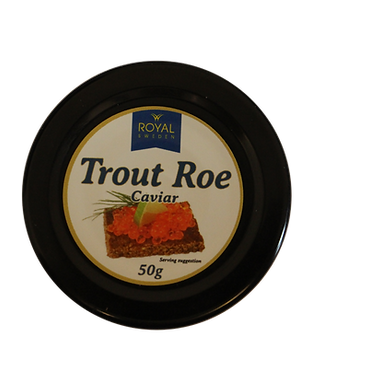
The Salmon Caviar!
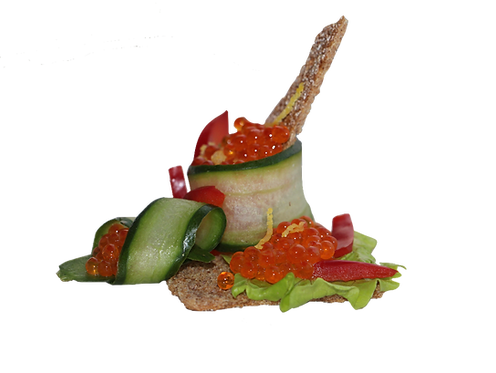

Trout Caviar 50g
The Salmon (Oncorhynchus keta),
Typically, salmon are anadromous: they are born in fresh water, migrate to the ocean, then return to fresh water to reproduce. However, populations of several species are restricted to fresh water through their lives. Various species of salmon display anadromous life strategies while others display freshwater resident life strategies.
Folklore has it that the fish return to the exact spot where they were born to spawn; tracking studies have shown this to be mostly true. A portion of a returning salmon run may stray and spawn in different freshwater systems. The percent of straying depends on the species of salmon. Homing behavior has been shown to depend on olfactory memory.
Nutritional Value
Salmon roe is an excellent dietary source of protein and the bene cial omega-3 fats, EPA and DHA. Per 1-ounce serving, roe contains slightly higher levels of EPA, DHA and protein than sh. Roe also provides small amounts of B vitamins, vitamin D, vitamin A and vitamin C. The orange-red color of salmon and salmon eggs comes from astaxanthin, an antioxidant carotenoid similar to lutein, lycopene and beta-carotene. Limited current research indicates that astaxanthin has bene cial e ects similar to other carotenoids for the skin, eyes, cardiovascular system and the immune system. (http://www.uaf.edu/files/ces/publications-db/catalog/hec/FNH-00130.pdf)
The Salmon Caviar
Our Salmon roe comes from wild catch fish; it is lightly salted and is very popular thanks to its fresh flavour and firm grains. The eggs are much bigger then the Trout and it's natural colour is golden or salmon pink.


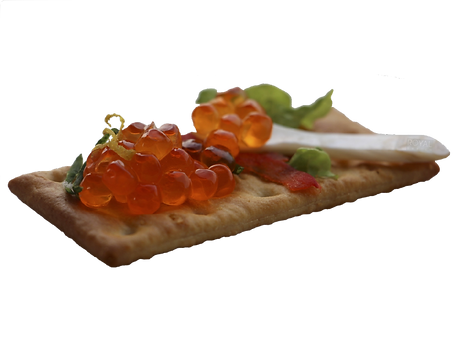
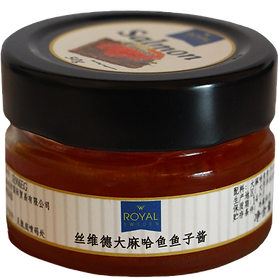
Salmon Caviar 50g


The Norwegian Arctic 52% Cod roe Tube Kaviar!
What does it really hide in a tube of caviar?
Caviar is a famous and good seafood that many have had in the fridge and on the breakfast table and a product often used in the famous "Smørgås" buffets in Scandinavia.
But what does the caviar tube really contain? Well, caviar consists of t sugar salt and smoked roe from fish and is added rapeseed oil, water, sugar, potato flakes, vinegar, preservatives and dye.
Egg, Tomatoes, cucumber and cabbage is the most common adds to use when making caviar. The roe is basically rich in protein, omega-3, vitamin D, vitamin B12 and iodine. But in Scandinavia the amount of roe used in the caviar varies from 32 to 60%, and of course it affects the amount of nutrients in the different variants.
The New Royal Sweden caviar Serie developed for the Chinese and Asian market, contains roe from 52 to 60%.
Our 60% Cod roe Children Design Kaviar is developed to reach the level of the requested Omega3 level in China. It is admittedly replaced with cod liver oil instead of rapseed oil, which increases the values of Omega-3, EPA+DHA
If you eat little fish and seafood, but like caviar, it's a contribution to getting some of the good nutrients that the food from the ocean offers.


